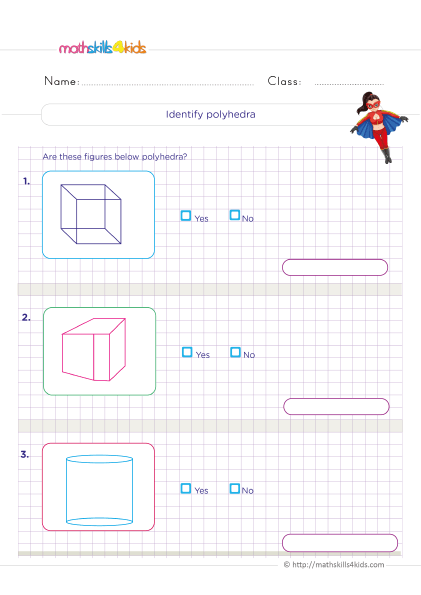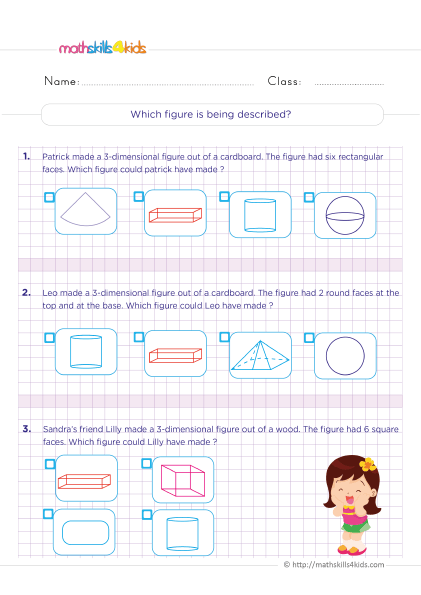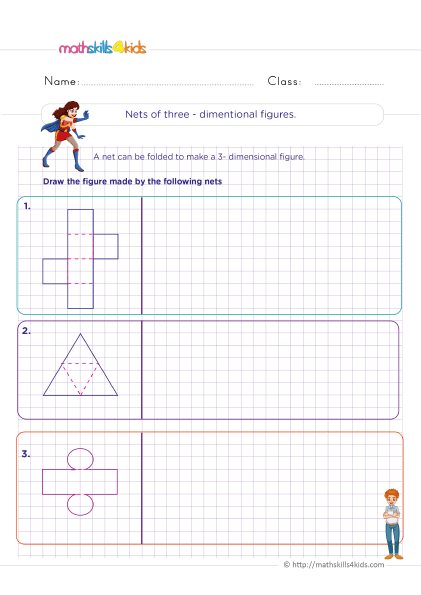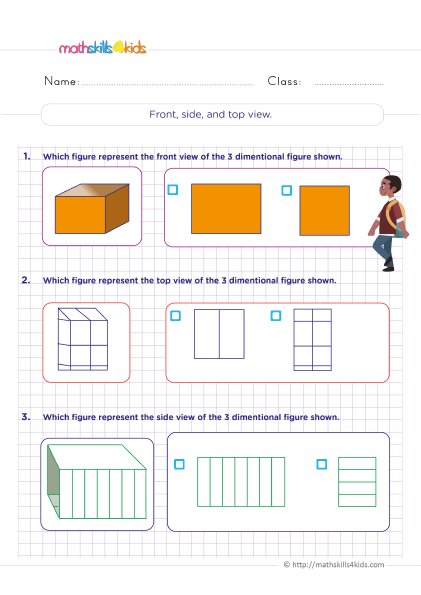6th Grade Math Worksheets: Properties and Characteristics of 3D Shapes
Hello, and welcome to our brilliant Math article about the properties and characteristics of 3D Shapes. To provide your 6th graders with a fun and interactive learning experience, we will encourage you to visit Mathskills4kids.com, a fantastic website with thousands of 6th-grade math worksheets you can download and print for free.
-
3D or 3-dimensional shapes are objects with length, width, and height. They are also called solid shapes because they take up space and have volume. We can touch and hold 3D shapes, unlike 2D shapes that are flat and only have two dimensions: length and width.
Master the vocabulary and concepts of 3D shapes with these worksheets for 6th-grade
Our primary objective in this article is to help 6th graders master the vocabulary and concepts of 3D shapes. That’s why Mathskills4kids’ properties and Characteristics of 3D Shapes worksheets for 6th grade have been chosen to engage students and enhance their learning experience.
In addition, this article will help 6th graders understand the importance of learning 3D shapes’ properties and characteristics, how to distinguish them from 2D shapes, what are the names and features of some common 3D shapes, how to make 3D shapes from flat shapes, and how 3D shapes are used in the real world.
So, if you want to improve your 6th graders' math skills or want them to love geometry, don’t hesitate to go through this article until the end.
Let's get started!
-
BROWSE THE WEBSITE
-
DOWNLOAD FREE WORKSHEETS
-
-
GRADE 6 MATH TOPICS
- Whole numbers
- Multiplication
- Division
- Exponents and square roots
- Number theory
- Decimals
- Add & subtract decimals
- Multiply & divide decimals
- Fractions & mixed numbers
- Add & subtract fractions
- Multiply fractions
- Divide fractions
- Integers
- Operations with integers
- Mixed operations
- Rational numbers
- Problems solving
- Ratio & proportions
- Percentages
- Measuring units
- Money math
- Consumer math
- Telling time
- Coordinate graph
- Algebraic expressions
- One step equations
- Solve & graph inequalities
- Two-step equations
- 2D Geometry
- Symmetry & transformation
- 3D Shapes
- Geometry measurement
- Data and Graphs
- Statistics
- Probability
-
Buying is supporting us!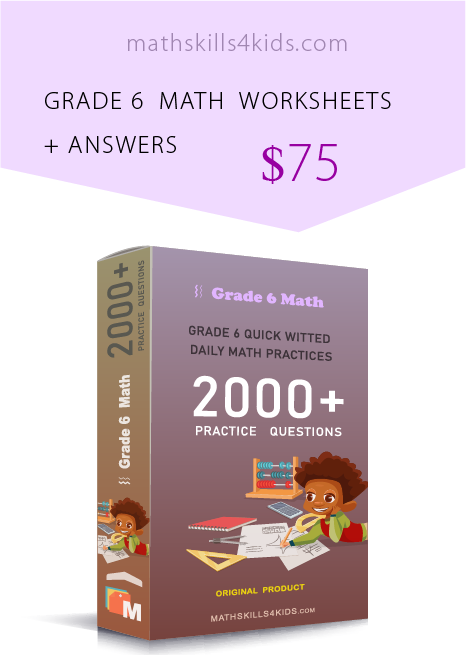
Buy Now...
-
-
Why are 3D Shapes important to learn about in 6th Grade?
Learning about 3D shapes is important for 6th graders because it helps them develop their spatial reasoning skills, essential for solving math, science, engineering, and art problems. By studying 3D shapes, 6th Grade students can also learn about their properties, such as surface area, volume, symmetry, angles, etc. These concepts will help students understand more advanced geometry and algebra topics later.
-
3D Shapes vs 2D Shapes: How to tell the difference between them and some examples of each
One way to tell the difference between 3D and 2D shapes is to look at their faces. Faces are the flat surfaces that make up a 3D shape. For example, a cube has six faces that are all squares. A 2D shape, on the other hand, does not have any faces. It is just a flat outline or boundary of a shape. For example, a square is a 2D shape with four sides and four corners.
Another way to tell the difference between 3D and 2D shapes is to look at their edges and vertices. Edges are the lines where two faces meet in a 3D shape. Vertices are the points where three or more edges meet on a 3D shape. For example, a cube has 12 edges and eight vertices. A 2D shape does not have any edges or vertices. It only has sides and corners.
Here are some examples of 3D shapes and 2D shapes:
- Cube: A 3D shape with six square faces, 12 edges, and eight vertices.
- Square: A 2D shape with four equal sides and four right angles.
- Sphere: A 3D shape that has one curved face that is round and smooth. It does not have any edges or vertices.
- Circle: A 2D shape that has one curved side that is round and smooth. It does not have any corners or angles.
- Cylinder: A 3D shape with two circular faces at the ends and one curved face around the middle. It has two edges and no vertices.
- Rectangle: A 2D shape with four sides and four right angles. Two opposite sides are equal in length.
- Cone: A 3D shape with one circular face at the base and one curved face that narrows to a point at the top. It has one edge and one vertex.
- Triangle: A 2D shape that has three sides and three angles.
-
Types of 3D Shapes: The names and definitions of the most common 3D shapes
On Mathskills4kids.com, there are many types of 3D shapes, but here are some of the most common ones:
- Cube: A cube is a rectangular prism with six square faces. All the faces, edges, and angles of a cube are equal.
- Sphere: A sphere is a round shape that has one curved face. Every point on the surface of a sphere is the same distance from the center.
- Cylinder: A cylinder is a shape that has two circular faces at the ends and one curved face around the middle. The height of a cylinder is the distance between the two circular faces.
- Cone: A cone is a shape that has one circular face at the base and one curved face that narrows to a point at the top. The height of a cone is the distance from the base to the vertex.
- Pyramid: A pyramid is a shape that has one polygonal face at the base and triangular faces that meet at a point at the top. The height of a pyramid is the distance from the base to the vertex.
- Rectangular Prism: A rectangular prism is a shape that has six rectangular faces. The opposite faces of a rectangular prism are parallel and congruent.
- Triangular Prism: A triangular prism is a shape that has two triangular faces at the ends and three rectangular faces around the middle. The opposite faces of a triangular prism are parallel and congruent.
- Pentagonal Prism: A pentagonal prism is a shape that has two pentagonal faces at the ends and five rectangular faces around the middle. The opposite faces of a pentagonal prism are parallel and congruent.
-
Faces, Edges, and Vertices: How to count and identify these features on different 3D shapes
To count and identify the faces, edges, and vertices of different 3D shapes, use these formulas:
- Number of Faces = Number of Edges - Number of Vertices + 2
- Number of Edges = 2 x Number of Faces - 4
- Number of Vertices = 2 x Number of Faces - 4
For example, to find the number of faces, edges, and vertices of a cube, you can use these formulas:
- Number of Faces = 12 - 8 + 2 = 6
- Number of Edges = 2 x 6 - 4 = 12
- Number of Vertices = 2 x 6 - 4 = 8
Your 6th graders can also use these formulas to check their answers by plugging in the values they found.
-
Nets of 3D Shapes: How to draw and fold flat shapes that can make 3D shapes
A net is a flat shape that can be folded to make a 3D shape. To draw a net of a 3D shape, we need to imagine cutting along its edges and unfolding it into a flat shape. We can use dotted lines to show where the folds are.
For example, here is the net of a cube:
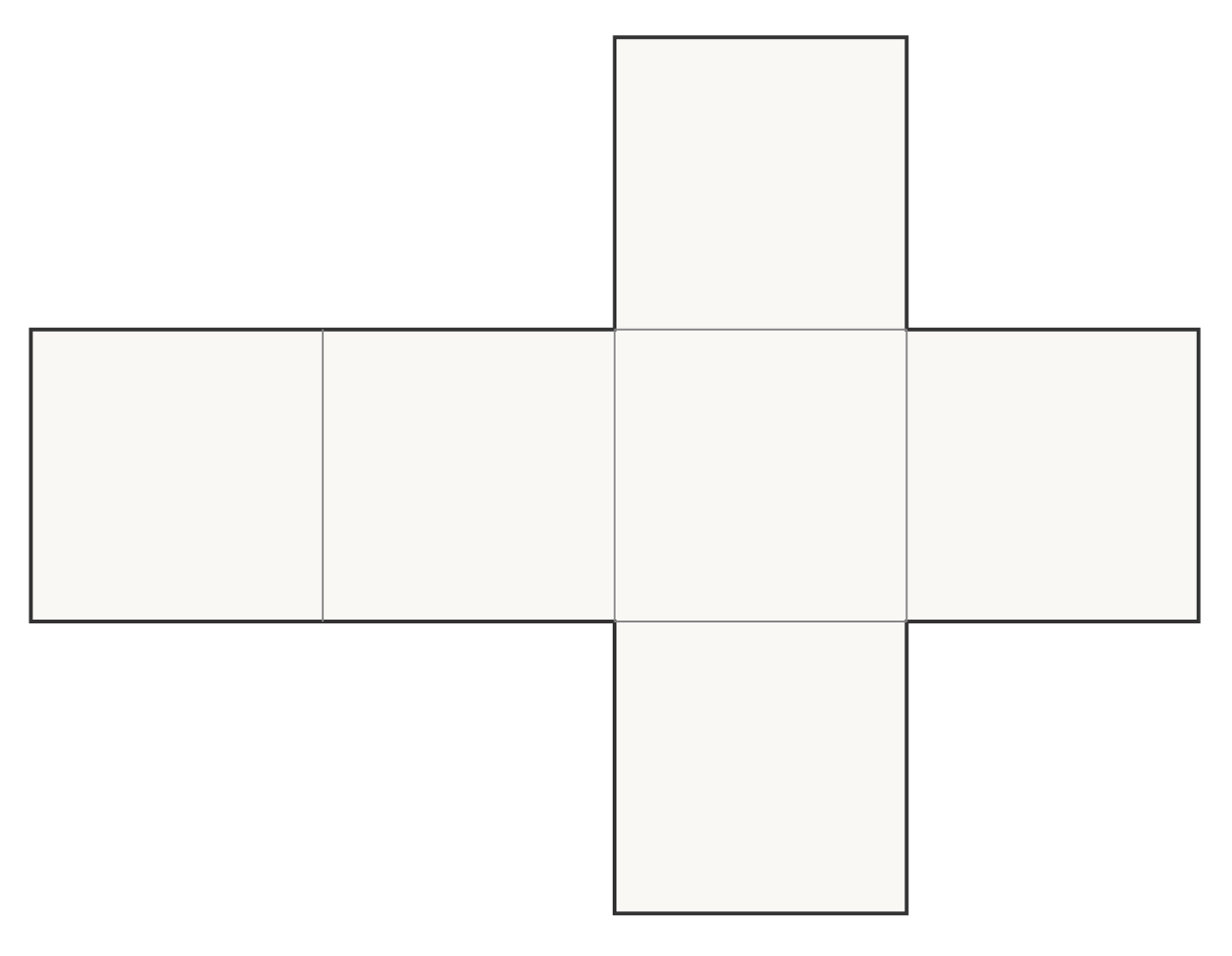
Net of a cube. To fold a net into a 3D shape, you must fold along the dotted lines and match the corresponding faces. You can use tape or glue to hold the shape together.
For example, here is how to fold a net into a cube:

Learn how to build a 2D net into a 3D cube. -
Real-World Applications: How 3D shapes are used in everyday life, such as architecture, art, engineering, etc.
3D shapes are fun to learn about and useful in everyday life. Here are some examples of how 3D shapes are used in different fields in everyday life:- Architecture: Architects use 3D shapes to design buildings, bridges, monuments, etc. They use different shapes to create different styles, functions, and effects. For example, pyramids are used to create ancient structures like the pyramids of Egypt or modern ones like the Louvre Museum in Paris.
Also, they use cylinders to create towers like the Leaning Tower of Pisa or skyscrapers like the Burj Khalifa in Dubai. Spheres are used to create domes like the Pantheon in Rome or geodesic domes like the Epcot Center in Florida.
- Art: Artists use 3D shapes to create sculptures, paintings, drawings, etc. They use different shapes to express their ideas, emotions, and messages. For example, cubes are used to create abstract art like the works of Pablo Picasso or geometric art like the works of Sol LeWitt.
Spheres are used to create realistic art like the works of Michelangelo or optical art like the works of Bridget Riley. Cones are used to create symbolic art like the works of Andy Warhol or kinetic art like the works of Alexander Calder.
- Engineering: Engineers use 3D shapes to create machines, devices, vehicles, etc. They use different shapes to optimize performance, efficiency, and safety. For example, they use rectangular prisms to create boxes, containers, laptops, etc. Spheres are used to create balls, wheels, planets, etc. Cones are used to create rockets, missiles, ice cream cones, etc.
- Architecture: Architects use 3D shapes to design buildings, bridges, monuments, etc. They use different shapes to create different styles, functions, and effects. For example, pyramids are used to create ancient structures like the pyramids of Egypt or modern ones like the Louvre Museum in Paris.
Bonus: More three-dimensional shape resources to reinforce 6th graders' math skills
If you want your 6th graders to learn more about the properties and characteristics of 3D shapes and practice their math skills, here are some fun and helpful resources that you can explore online with them:
- 3D Shapes Game: This is an interactive game where students will identify and match different 3D shapes with their names and properties. They can choose from four difficulty levels and challenge themselves to beat the timer. https://www.education.com/games/3d-shapes/
- 3D Shapes Worksheets: These are printable worksheets that 6th graders can use to review and test their knowledge of 3D shapes. They can find worksheets on drawing nets, counting faces, edges, and vertices, finding surface area and volume, etc. https://www.mathworksheets4kids.com/solid-shapes.php
- 3D Shapes Videos: These are short and engaging videos that explain various concepts and facts about 3D shapes. Students can watch videos on how to make 3D shapes from paper, clay, or straws, how to find the volume of a sphere, how to classify prisms and pyramids, etc. https://www.khanacademy.org/math/geometry/hs-geo-solids/hs-geo-solids-intro/v/solid-geometry-volume
- 3D Shapes Quiz: This online quiz helps to check 6th graders’ understanding of 3D shapes. They can choose from multiple-choice or fill-in-the-blank questions and get instant feedback on their answers. https://www.sporcle.com/games/t_rev19/3d-shape-volume-formula-matchup
-
-
Thank you for sharing the links of MathSkills4Kids.com with your loved ones. Your choice is greatly appreciated.
Conclusion
In this article, we have learned about the properties and characteristics of 3D shapes and how they differ from 2D shapes. We have also seen some examples of 3D shapes in the real world and how they are useful for various purposes.
We hope you have enjoyed reading this article and found some new and exciting things to teach your 6th-grade math students about 3D shapes.
Remind them to practice their math skills with the resources we have provided and have fun exploring the world of three dimensions!
